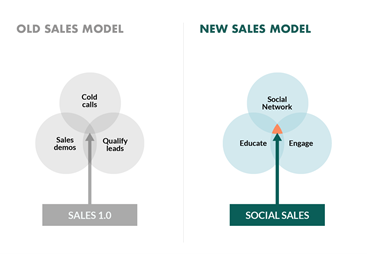
Social media is a pretty big deal in 2020. It was a pretty big deal back in 2010! But now, even more so.
Literally billions of people spend hours a week, sometimes hours a day, scrolling through their social media feeds, engaging in content that interests them.
Businesses came to realise pretty quickly that social media is a pretty useful tool to reach their potential customers.
Social selling was born as a way to communicate with potential customers through social media, in a less obtrusive way than traditional marketing.
So how do we do this?
What is Social Selling?
Social selling is the use of social media to research, find, and understand sales prospects, to network and engage in conversations in online communities with them, to build and strengthen relationships.
“Social selling is taking out the pitching component of sales. You’re creating conversations about your product and services which organically can produce sales conversations.” (LinkedIn)
The aim is to provide value to prospective customers through answering questions, responding to comments and sharing content related to your area of expertise.
Prospect cans are anywhere throughout the buying process — from awareness to consideration. The idea is to consistently provide value, so you are the first person or brand a prospect thinks of when they are ready to buy.
Digital marketing principles can implement at an individual salesperson level or a firm level, but social selling requires an investment of time, effort, money and technology. It can be done on a shoestring budget, but to create quality content, we need to invest in our social selling strategy.
The popularity of social media makes it a perfect platform to build relationships with prospects. Through an emphasis on social interaction and content creation via digital platforms, social selling could be considered sales 2.0. The image below illustrates how it differs from the traditional sales model.

“Social selling is the identification, targeting and reaching out to prospective and existing customers through social media channels and social communities in an effort to engage them in conversations that result in a potentially mutually beneficial relationship.” (Belew, 2014)
According to Statista, around 3.6 million people are using social media in 2020. By 2016, approximately 71% of all sales professionals were social selling in some way or form, even if they did not know it.
Having a business page on Facebook or commenting on posts in groups on LinkedIn for example are social selling tactics. It is not about bombarding strangers with private messages selling something after you connect on LinkedIn.
That is spam and the opposite of what you should do.
Sales strategy has always revolved around building and strengthening relationships to establish rapport and credibility with prospects and customers, so you are the one they think about when they require a solution to their problem, that you provide.
Social selling uses this same methodology but does it online with social media instead of requiring cold or warm calling or sales demos.
It might not be a surprise to you to hear that not many people enjoy doing cold calling and that many people do not like to receive cold calls. According to the Harvard Business Review, 90 percent of decision-makers say they never respond to cold calls. This means it can take numerous cold calls to reach a potential client if you can reach them at all.
“The approach is not simply another sales channel for making sales pitches but a way to engage the informed, empowered, and social buyers during their purchasing journeys using digital and social channels.” (Ancillai, Terho, Cardinali, & Pascucci, 2019)
Social selling for B2B
Social media was is largely a personal tool — we use Facebook to keep in touch with friends and family, for example. However, it has also become a personal branding tool. Read my blog about social media trends in 2020.
I used LinkedIn originally when I went into real estate a did not have much of a network locally. Grow awareness that I was a real estate agent. I did this by educating people about the local market and real estate in general, I was an ambassador for growth/construction in the city and a little bit of real estate content. Maybe 1 or 2 out of every 10 posts was about a listing for sale.
This is how I stood out when every other real estate salesperson, who was pretty much posting 100% of content about what they had for sale or what they had sold. This felt natural to me.
Social selling was not a thing when I did my marketing degrees, but it follows the foundations of relationship marketing and content marketing.
Using social selling is mutually beneficial to customers and sellers.
Businesses using social media to inform and educate prospects is useful to buyers, as social media can be an important part of their research process, influencing their decision-making. Several studies over the past five years have indicated that over 90 percent of B2B buyers conduct research online and through social media before making a business purchase. Over 80 percent of senior executives use social media to aid their purchase decisions.
Buying behaviour has changed in B2B markets. According to LinkedIn, 73% of B2B buyers prefer sales professionals who have been referred by someone they know; therefore, their professional networks are a valuable information resource.
87% of B2B buyers saying they would have a favourable impression of someone introduced through their professional network.
“Unlike traditional advertising, social media marketing lets you engage with online prospects and customers.” (Belew, 2014).
The benefits of social selling
Through social selling, Sellers can identify new leads through pinpointing who is talking about their brand, competitors or their industry. These prospects can then be engaged in a way that is useful to them.
Social selling does not disrupt its target audience the way that traditional marketing does, it is a two-way conversation, unlike traditional sales which are only one-way.
A major benefit of social selling is the low cost. Social media profiles are free and a lot of the activities you can use to grow your brand and reach customers are free or very low-cost, making social selling an affordable marketing strategy for any business.
Social media users can often share a lot of information about themselves online. A LinkedIn profile for example could contain most of the information you need to make a personalised and relevant first point of contact with a prospect.
Through social selling, a salesperson can grow their personal brand to increase their credibility and the quality of their customer leads.
Introductions to potential customers can be gained through existing mutual connections or them viewing your content over a period — may be unbeknown to you, which creates a sense of trust and rapport.
“Salespeople have long leveraged offline social networks… All things being equal, people prefer to buy from those they know and trust. Now, sales professionals need to replicate their networking strategy online because social media is where peer conversations are happening.” (Schaub, 2014)
Actively social selling increases the number of visits from your social media channels to your website, as well as increasing the number of leads that your social media generates.
Because the leads generated through social media are of a higher quality and you have already established credibility and trust, there is an improved conversion rate than from other sales activities such as cold calling.
Social selling encourages a stronger alignment between sales and marketing, which will be discussed a bit further on in this article.
Optimising your social selling strategy
First up in your social selling strategy, as with any strategy, you must establish goals and objectives. The general goal is to establish relationships that lead to sales, but we must work out smaller more specific goals and objectives to help get you there.
An individual should spend around six to 15 hours a week on social selling. It might be around 20 to 40 percent of their allocated work time. It is key to identify and target the most relevant social media networks where potential customers are active.
Therefore, I found in bizarre in 2019 when marketers started telling businesses they should be active on TikTok while there’s enormous organic reach. Well, only if your customers are teenagers! It seemed strange preaching this on LinkedIn — largely is a B2B platform.
For retail, it would be Pinterest, for hospitality Instagram or Facebook, and for tourism, YouTube would be useful.
Here are ten ways to optimise your social selling strategy.
1. A completed and professional profile
Make sure you complete every section of your social media profiles. Especially on LinkedIn. If someone clicks your profile, you want them to be able to find out what you do, how you add value, a link to your website and any contact information so they can easily get in touch.
Look at your profile from the point of view of a potential customer. Does your profile reflect that you are a credible professional?
2. Follow relevant brands and people
Follow local companies, brands and influencers in your industry.
This would be one of the first steps after creating your profile. This will start filling your feed with relevant content.
Any ‘dream’ clients you may have, send a connection request to relevant people in the organisation and if they decline (send them a personalised message with your request to increase your chances), follow them so you can keep up with what they post.
Engage in their content and congratulate them on any achievements. Saying something insightful could mean they check out your profile it could go from there.
3. Join and participate in groups
There are literally millions of groups on both LinkedIn and Facebook. Each group will have its own purpose or theme. It is a community. It might be a gardening group, or it might be a group about marketing.
Join groups relevant to your area of expertise and industry. For example, if your target customers are small business owners, join groups relating to small businesses.
Use keyword searches to identify relevant groups and once in these groups, share your knowledge and expertise — do not try and sell!

4. Create and share relevant content
Content in social selling is used as a touchpoint to engage and nurture leads through educating and informing them.
Through sharing interesting and relevant and information-rich content, social presence is enhanced. This presence helps brand us as an expert and build familiarity and eventually trust with our target prospects. Social media is an important information source for purchasers, so we want to increase the chances of them finding our content.
Create and then share content based on your expertise. Think from the perspective of your target audience and try and create valuable content they would find useful or interesting.
Look at the news, use Google Trends, look at the content of influencers in your industry or create content based on questions or topics discussed in your network.
The aim is to provide valuable information to the right people at the right time — when they are ready to purchase. Through consistently sharing content in a particular niche or topic, our social media profiles are also more likely to show up when potential customers are searching for people with expertise in that area.
“You need a lot of content to build relationships and keep the sales funnel fed.” (Belew, 2014)
5. Do not be too ‘salesy’!
It is okay to mention your products or service in a small portion of your social posts but only do it once or twice every 10 posts or so. Do not try and pitch yourself nine or 10 out of 10 posts! People quickly tune out.
Our tone should be consultative — giving professional advice or recommendations free of charge rather than trying to sell something. The goal is to contribute valuable information to enhance your credibility and position you as an expert in your industry.
If you are going to pitch to somebody, wait for the right moment. This is not when you connect! It is when they post asking for a recommendation in the industry you are in. Or maybe you picked up other subtle hints they might need help. Maybe you met them in passing at a networking event and they mentioned they need some help with something aligned with what you do.
“Aggressive selling techniques are likely to be ignored on social media.” (Belew, 2014)
6. Expand your network
One of the easiest things you can do to grow your social presence is to expand your social networks to connect with more of the people. Connect with people as much as possible and strive to create content that will encourage people to like your page, follow or connect with you.
LinkedIn provides search functionality to search for people based on location and job title/industry, so it allows you to send connection requests or follow people that match your buyer personas/target segments of the market.
7. Build mutual relationships
When you connect with prospects, stay in touch with them over time and engage in their content. Not every single post, but enough so they recognize you. Like their content as well as posting an insightful comment or say thanks by letting them know that you appreciated their post. Learn who people are and what is important to them.
“The effectiveness of social selling is likely to be contingent on the salesperson’s simultaneous use of customer oriented selling approaches.” (Ancillai, Terho, Cardinali, & Pascucci, 2019)
If you are relationship-focused, you are more likely to understand prospects and existing customers and where they are in their buying process. It is a good idea to find prominent social connectors or influencers in your industry and connect if possible or at least engage in their content, so their following gets to know you.
If a contact moves to a new position or company, LinkedIn makes it easy to send a quick note of congratulations by sending you a notification.
If you notice a contact asking for help or advice, add value through sharing knowledge freely. People seek trust and confidence from social connections, especially those they might do business with.
Facilitate bringing people together for mutual benefit, if someone asks for a recommendation for example and somebody in your network is a good fit. Rarely ask for favours and instead give to others where possible and the business should come back to you.

8. Be active and engage
Participate and engage in conversations actively, to build relationships.
Digital tools such as bots who use AI to have conversations do have some advantages in marketing and customer service, but with selling, people do business with other people. So, do not be robotic in your engagement, show some personality and do not be afraid to use a bit of humour. Be yourself — you will seem approachable. This is where that authenticity word comes in.
Respond to what people are saying about your brand or your industry. Use the search function to find relevant content you can ‘like’ or answer questions and give recommendations based on your knowledge.
Do not limit the conversations you join to strictly business. Family or leisure related content you engage in will help position you as someone who cares. Make sure your tone is consistent — if you seem to have multiple personalities, you probably will not seem too trustworthy.
Be patient — do not expect leads overnight. It takes consistency over a long period until people start to recognise who you are, what you do and start to trust your expertise.
9. Integration
Social selling is cross-functional with many components. Within an organization, a social selling team should be made up from customer service, marketing and sales.
Having sales and marketing teams aligned is a good idea anyway as there is now a lot of overlap with digital marketing. A customer service representative can help monitor social media and respond to any basic questions.
Having these three areas integrated means they are aligned and share data that can help them all do their jobs better.
“Social Selling is simply a by-product of effective sales and marketing alignment at scale across your organisation. Streamlined communication bridges between sales and marketing, which have increased the flow of new ideas for digital insights.” (Shanks, 2016)
10. Research
Before you start social selling, you need to identify the social media networks that are the best fit for your business. This might be obvious, but it may take a little research.
Paid Social listening tools such as Hootsuite or Falcon or using social searches with keywords will help you uncover data to monitor and analyse what people are talking about online regarding your brand, competitors or industry which will help discover customer prospects. People share useful information on their social media — sometimes what they want and need.
You can learn from this. You can learn how people feel about your brand and what they think of your competitors.
Look for issues people are having or recommendations, providing natural opportunities for you to provide the solution to a problem. Pay attention to influencers in your niche and see what strategies they are using to generate a following and implement some of these into your strategy.
Tips for social selling on different social media networks
With the best practices above in mind, here are some specific tips for getting started with social selling on LinkedIn, Twitter, and Facebook.

LinkedIn is the most obvious social network to engage in social selling, being a business social network. Now with close to 700 million users, if you are in B2B, LinkedIn is by far the best source of leads.
Back in 2016, LinkedIn boasted that 50% of B2B buyers use LinkedIn as a resource when making purchasing decisions. Now it is reported that Eighty percent of leads sourced for B2B marketing come via LinkedIn.
From having a professional headshot to asking for recommendations and endorsements. Read my blog about optimising your Linkedin strategy to attract more leads.
When you begin to contribute, you will find that more people will view your profile. If they do this, send them an invitation to connect.
LinkedIn Social Selling Index
Social Selling Index (SSI) measures how effective you are at establishing your professional brand, finding the right people, engaging with insights, and building relationships.
LinkedIn says “Sales reps that use social selling sell more and reach their targets faster.”
They encourage the practice, asserting that social selling leaders get “better results” and boasting that “78% of social sellers outsell peers who don’t use social media.”
LinkedIn has four elements of social selling to measure a person’s social selling performance:
- Establish your professional brand — An optimised profile with the customer in mind and posting meaningful and relevant content for relating to your industry, establishing you as a thought-leader.
- Find the right people — know what type of people you are looking for and identifying customer prospects using keyword searches. LinkedIn also provides paid research tools such as Sales Navigator (using this will give you a higher score for this element). Find similar people both in your industry and in the industry of your ideal client.
- Engage with insights — Share content from other people or brands you find interesting. Have conversations with people through commenting on posts in your feed or join active groups relevant to your industry and authentically share your expertise without promoting something.
- Build relationships — Establish trust with prospective customers, influencers, people in your local business community and decision-makers. This will strengthen your network and help you stay top of mind. I have the opinion that anybody on LinkedIn is a worthy connection as through connecting with them, someone else relevant might see your engagement.
Start ‘social listening’ — create Twitter Lists to monitor content from specific groups of people. Create individual lists for existing customers, prospects, influencers, competitors. Twitter has become so influential that Nielsen launched a Twitter TV Rating to rank the social engagement of TV programs and events.
Do not be too sales-focused with your tweets (Twitter posts). A ratio of roughly one or two ‘selling’ posts per 10 posts is plenty.
Facebook is the most ‘personal’ of the three social networks discussed. Some people will not want to accept random friend requests from someone they might have met once or twice in a business context, so Facebook does not work in the same way as Twitter or LinkedIn where anyone can see your content.
Depending on who your friends are, social selling on your personal account might be wasted effort unless you have a lot of professional friends.
Works the same way. Share expertise and engage. Join relevant Facebook groups and engage there. You should also create a Facebook Business Page, invite relevant friends and use the same strategies with your page — create value and engage.
Summary
In sum, Social Selling is the use of social media by businesses, as a marketing, branding, customer service and sales tool.
Instead of using traditional approaches like cold calling and advertising, the emphasis is on creating value for potential customers to form and strengthen relationships.
This article has explored social selling and how it works, the benefits of social selling and ten tips to optimise your strategy.

No comments:
Post a Comment